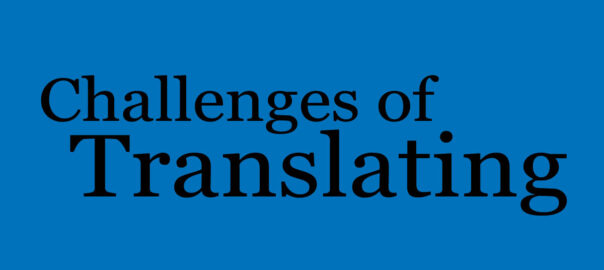Nirendra Nath Thakuria
Translation is the communication of the meaning of a source language text by means of and equivalent target language text. (https://en.m.wikipedia.org.) In the age of globalization, translation has emerged as a discipline of serious studies and grown in importance as a bridge between languages, literatures, cultures and societies.
“…translation can be compared to building bridges or extending horizons, metaphors which pointed to positive, enabling function of translation. In this sense translation can be seen as a service: it serves a need of human beings, apparently have to transcend the world to which their own particular languages confine them. Translations mediate between languages, societies, and literatures, and it is through translations that linguistic and cultural barriers may be overcome.” (House 3)
A person who wants to be a translator must have great proficiency in both the languages – source language and target language. Moreover, s/he must have familiarity with the both the cultures of which the languages concerned are part. The language proficiency of the translator can be shown as follows:
Source Language (SL)≤ Target Language(TL)
Many translators including Khushwant Singh, noted journalist and fiction writer, hold that the translator should have greater proficiency in the target language.
Basic questions for the translator
Who is the author whose work the translator has chosen for translating?
What work/text is chosen by the translator for translating?
Who are the translator’s target readers?
Why is the translator going to translate a particular text/work?
How is the translator going to translate a particular text/work?
These are the determining factors for the translator. The purpose/skopos of the translation project is the guiding force of the translator. Many shining examples can be cited from the Bhakti movement in India.
Also Read : Study of Poetry Free from Difficulty
During the Bhakti movement in India, both The Mahabharata and The Ramayana were translated into vernacular languages. For example, Madhav Kandali translated The Ramayana into Assamese. Sarala Das translated The Mahabharata into Oriya. Goswami Tulasidas’s Ramcharitmanas is the culturally defining translation of The Ramayana. Both Sankaradeva and Madhavadeva engaged themselves in translating the Bhagavata Purana for propagating the Neo-Vaishnava tenets among the common masses in Assam. The Bhakti movement produced a significant number of excellent transcreations.
It is well known that the Bible translation contributed, in a big way, to the rise of modern European languages. In his scholarly Assamese essay “Anubadar Katha”, eminent scholar K. K. Handiqui very convincingly showed how the eastern European languages (Czech, Hungarian, and Serbian) revived through translation works.
Also Read : Imaging Assamese Poetry through Ecofeminism
Choice of the text and the author depends on the translator’s idiosyncrasy or philosophy. Very often the current trend may become the motivating factor for the translator. How does the translator try to translate the text of his choice?
“… translators are first and foremost mediators, they are the medium by which texts from one culture and language are transmitted to another.” (Cronin 124)
The translator is expected to be the model reader who comprehends the content and the message and captures the spirit, the tone, and verbal artistry of the source text. Obviously, the translator comes across different areas and levels of problems.
Problem areas
Translation is a subtle creative process that involves the complexities and nuances at several levels – phonological, morphological, syntactic, semantic, pragmatic, stylistic, cultural and ecological.
The most challenging problem the translator has to overcome is finding the source language/culture equivalence in the target language/culture. In each creative work, there is some meaning at the core. The invariant core (Popovič’s term) is represented by stable, basic and constant semantic elements in the text. But there may the indefinable quality in the text that may becalled the nature/spirit/soul of the text.
Untranslatability
Some texts are really difficult to translate. J. C. Catford mentions two types of untranslatability – linguistic and cultural (Bassnett 37). I would like to cite two instances here: (1) Nilmani Phookan’s famous Asssamese poem “Topanito teÕ mok khedi phurichil”. In Assamese ‘teÕ’ (3rd person, singular number, nominative case) is pronoun that respectfully may refer to a male or female person depending on the context of situation. When the context is deliberately ambiguous, the linguistic problem of finding an equivalent in English remains unsolved. (2) The expression xonar xoleng in Parvatiprasad Barua’s famous lyric “Been Boraagee” has hardly any equivalent in English.
It must be kept in mind that culturally-rooted terms, belief system, and ecology pose major challenges even to the most accomplished translators. Moreover, very personal experience in its uniqueness is untranslatable.
Translator’s dilemma
In translating a work, the translator may be in a dilemma – to conceal or to reveal the foreignness of the source text. Juliane House coined two useful terms – Covert and Overt translation. Covert translation: A translation which conceals anything that betrays the foreignness of a source text. Overt translation: A translation which shows the foreignness of a source text.
Lawrence Venuti also offers two similar terms – Domestication and Foreignization. Domestication is a translation strategy in which a transparent, fluent style is adopted in order to minimize the foreignness of a source text. Foreignization is that strategy of translating that seeks to preserve the ‘alien’ features of a source text in order to convey the foreignness of the original. Translating is both challenging and elevating as it is a subtle complex creative process. It is an art of revision. Although something is lost in the process, the gain is enormous. A good translation opens a door to the inquisitive traveller. The translator plays a crucial role as s/he is the creator of a substitute text that must stand as an independent text.
Works Cited
Bassnett, Susan. Translation Studies. London : Routledge, 2002.
Cronin, Michael. Translation and Globalization. London: Routledge, 2003.
House, Juliane. Translation. Oxford: OUP, 2009.
https://en.m.wikipedia.org/wiki/Translation
Nirendra Nath Thakuria, retired Associate Professor of English, is a translator.

Very informative article for literary translators.